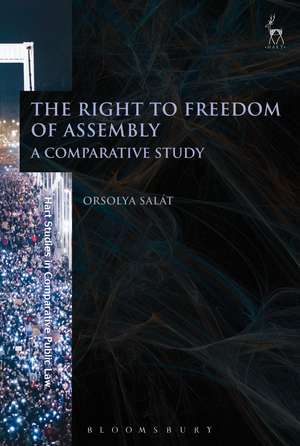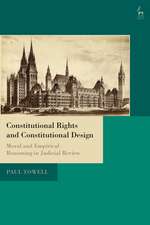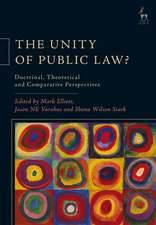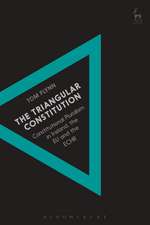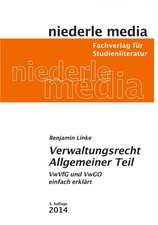The Right to Freedom of Assembly: A Comparative Study: Hart Studies in Comparative Public Law
Autor Orsolya Saláten Limba Engleză Paperback – 23 aug 2017
| Toate formatele și edițiile | Preț | Express |
|---|---|---|
| Paperback (1) | 273.42 lei 6-8 săpt. | |
| Bloomsbury Publishing – 23 aug 2017 | 273.42 lei 6-8 săpt. | |
| Hardback (1) | 600.06 lei 6-8 săpt. | |
| Bloomsbury Publishing – 20 mai 2015 | 600.06 lei 6-8 săpt. |
Din seria Hart Studies in Comparative Public Law
- 22%
 Preț: 270.67 lei
Preț: 270.67 lei - 18%
 Preț: 305.41 lei
Preț: 305.41 lei - 18%
 Preț: 323.38 lei
Preț: 323.38 lei -
 Preț: 380.87 lei
Preț: 380.87 lei - 23%
 Preț: 386.15 lei
Preț: 386.15 lei - 22%
 Preț: 251.39 lei
Preț: 251.39 lei - 18%
 Preț: 440.31 lei
Preț: 440.31 lei - 22%
 Preț: 227.81 lei
Preț: 227.81 lei - 22%
 Preț: 270.67 lei
Preț: 270.67 lei - 27%
 Preț: 349.13 lei
Preț: 349.13 lei - 22%
 Preț: 272.51 lei
Preț: 272.51 lei - 22%
 Preț: 270.49 lei
Preț: 270.49 lei - 22%
 Preț: 226.42 lei
Preț: 226.42 lei - 23%
 Preț: 171.85 lei
Preț: 171.85 lei - 30%
 Preț: 576.15 lei
Preț: 576.15 lei - 30%
 Preț: 900.07 lei
Preț: 900.07 lei - 18%
 Preț: 380.74 lei
Preț: 380.74 lei - 21%
 Preț: 279.85 lei
Preț: 279.85 lei - 22%
 Preț: 251.75 lei
Preț: 251.75 lei - 17%
 Preț: 315.19 lei
Preț: 315.19 lei - 18%
 Preț: 321.78 lei
Preț: 321.78 lei - 21%
 Preț: 236.30 lei
Preț: 236.30 lei - 18%
 Preț: 321.78 lei
Preț: 321.78 lei - 30%
 Preț: 960.98 lei
Preț: 960.98 lei - 22%
 Preț: 271.94 lei
Preț: 271.94 lei - 22%
 Preț: 239.59 lei
Preț: 239.59 lei - 18%
 Preț: 322.15 lei
Preț: 322.15 lei - 22%
 Preț: 264.17 lei
Preț: 264.17 lei - 22%
 Preț: 264.57 lei
Preț: 264.57 lei
Preț: 273.42 lei
Preț vechi: 349.57 lei
-22% Nou
Puncte Express: 410
Preț estimativ în valută:
52.32€ • 54.63$ • 43.20£
52.32€ • 54.63$ • 43.20£
Carte tipărită la comandă
Livrare economică 15-29 aprilie
Preluare comenzi: 021 569.72.76
Specificații
ISBN-13: 9781509916016
ISBN-10: 1509916016
Pagini: 314
Greutate: 0.5 kg
Ediția:NIPPOD
Editura: Bloomsbury Publishing
Colecția Hart Publishing
Seria Hart Studies in Comparative Public Law
Locul publicării:London, United Kingdom
ISBN-10: 1509916016
Pagini: 314
Greutate: 0.5 kg
Ediția:NIPPOD
Editura: Bloomsbury Publishing
Colecția Hart Publishing
Seria Hart Studies in Comparative Public Law
Locul publicării:London, United Kingdom
Caracteristici
This comparative study of freedom of assembly examines five influential jurisdictions in Western human rights jurisprudence, and reveals similarities and inconsistencies between them.
Notă biografică
Orsolya Salát is an Assistant Professor of Human Rights and Comparative Constitutional Law at the ELTE University, Faculty for Social Sciences, Budapest.
Cuprins
Introduction I. The Challenge of Freedom of Assembly II. A Concept of Assembly III. Structure Chapter 1: Origins, Forms and Values I. Historical Origins of the Right to Freedom of Assembly II. Meeting, Marching or Speaking: Forms of Assembly III. Fundamental Right, or 'Mere' Common Law Liberty IV. The Value of Freedom of Assembly: Contemporary Judicial Rationales Chapter 2: Prior Restraints, Exemptions and Bargain I. Prior Restraint in General II. Advance Notice or Permit III. Prior Ban and Conditions IV. Exemptions, Derogations from the Notification Requirement Chapter 3: From Violence to Public Disorder to Crime Prevention I. The Peacefulness Requirement: A Determinant of Scope or a Limit II. The Would-be Disorderly: Judicial Doctrines of Risk-assessment Chapter 4: From Coercion to Direct Action to Disruption I. Nötigung in Germany II. United Kingdom: Disruption, Obstruction and Many More III. United States: Inconsistency Masked by Content-neutrality IV. France: Pressure Inherent in Strike V. European Court of Human Rights: No Violation Chapter 5: Dignity as Peace, Truth and Love I. Germany: Dignity and its Substitute 'Public Peace' II. France: Dignity as Public Order and Officially Declared Truth III. United States: Dignity as Non-Argument IV. United Kingdom: Dignity Under Different Names V. European Court of Human Rights: Hate Speech Chaos Chapter 6: Restrictions on the Time I. Special Days of the Year: The Notion of Public Order in Germany II. Duration, Time Limit, Frequency Chapter 7: Restrictions on the Manner I. Banned and Protected Symbols: Whose Identity? II. Uniforms and Masks: Whose Fear? III. One Man's Noise is Another's Music IV. Modes and Means of Protest as Aesthetic Harm Chapter 8: Restrictions on the Place I. Private Public Places II. Governmental Buildings: Managerial or Authoritarian Protection? III. Memorial Sites: Identity Fight over Collective Memory IV. Designated Zones: Speech Pens, Protest Cages Conclusion I. Specific Comparative Findings II. General Evaluation and Suggestions
